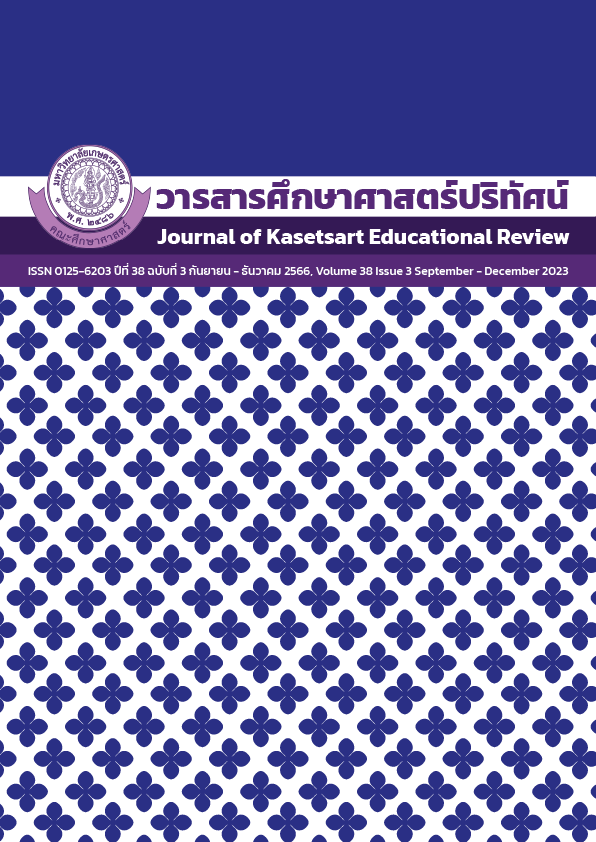The Relationship between Smartphone Use Behavior and Academic Achievement under the New Normal of students in schools the Bangkok Metropolitan Administration, Nong Chok District
Keywords:
smartphone use behavior, academic achievement, new normalAbstract
The objectives of this research were: 1. To compare the behavior of using smartphone of students classified by sex, grade level, and duration of using smartphone; 2. To compare the academic achievements were classified by sex, grade level, and time of smartphone use; 3. To study the relationship between the students' smartphone use behavior and the student's academic achievement. The sample group was 670 students in Nong Chok Bangkok in P. 5 - M. 2 at the ages of 10-14 years. The tools used in the research was a questionnaire on the behavior of using smartphone. Analyze data with statistical software packages. The statistics used were percentage value, arithmetic mean, standard deviation, t-test independent, One-way analysis of variance F-test (One-Way ANOVA), and Pearson Product Moment Correlation.The results showed that students had the behavior using smartphone was at a moderate level ( =3.24, SD. = 0.67). There were significantly different averages of the behavior of using smartphone between sex, grade level, and duration of using smartphone at the 0.05 level. The comparison of learning achievement classified by sex and grade level was significantly at the 0.05 level. There was no significantly different time of smartphone use. And the students' smartphone use behaviors were not correlated with academic achievement.
References
Aumthip, S. (2019). Mobile Phone Usage Behavior of Students Studying in Social Studies Program of Thepsatri Rajabhat University. Mahachula Academic Journal, 6(special edition), 26-38. [In Thai].
Beland, L.P. and Murphy, R., (2015). CEP Discussion Paper No 1350 May 2015 Ill Communication: Technology, Distraction & Student Performance. https://cep.lse.ac.uk/pubs/download/dp1350.pdf.
Bunga, C. & Pornphan, P. (2015). New media use behavior of adolescents between the ages of 10-19 years. Journal of Communication and Management, 1(1), 31-57. [In Thai].
Chanida Y. & Kanchana B. (2016). Factors Affecting Learning Achievement of Students in Schools under Prachuap Khiri Khan Primary Educational Service Area Office 2. Veridian E-Journal, 9(1), 1028-1223. [In Thai].
Education Bureau Bangkok. (2021). Educational statistics report, academic year 2021, schools under Bangkok. https://webportal.bangkok.go.th/upload/user/00000116/PTay/EbookStat64.pdf.
Elammari, H. & Cavus, N. (2019). Investigating the Factors Affecting Students’ Smartphone Purchasing Behaviors in the Context of Mobile Learning. International Journal of Emerging Technologies in Learning (iJET), 14(22), 111-121. DOI:10.3991/ijet.v14i22.11748.
Khim, S. (2022). DataReportal, Digital 2022 Global Digital Overview. https://datareportal.com/reports/digital-2022-global-overview-report.
Lawrenz, F., Wood, N. B., Kirchhoff, A., Kim, N. K. & Eisenkraft A. (2009). Variables affecting physics achievement. Journal of Research in Science Teaching - Wiley Online Library. 46(9), 961-976. https://doi.org/10.1002/tea.20292.
National Statistical Office Ministry of Digital Economy and Society. (2022). 16 Technology Statistics of Information and Communication Technology http://statbbi.nso.go.th/staticreport/page/sector/th/16.aspx. [In Thai].
Nongluck, W. (1999). Lisrail model: statistical analysis for research. 3rd printing, Bangkok: Printing house of Chulalongkorn University. [In Thai].
Panjaporn, K. (2022). Social Media use Behavior and Social Media Literacy Among Students in Changklangprachanunkul School Nakhon Si Thammarat Province. Journal of MCU Nakhondhat, 9(6), 198-211. [In Thai].
Panuwat, K. (2011). A study of behavior of adolescents using social networks in Thailand : Case Study Facebook. Master of Science Graduate School, Kasetsart University. [In Thai].
Pitchada, P., Thanawat , S. & Sarawut, T. (2021). Final Report: Project name Smart Phone Addiction Behaviors and the causal relationship model of Smart Phone Addiction Behaviors among Generation Z in Bangkok. Retrieved from: https://cads.in.th/cads/media/ upload/1613441962-2. บทความวิจัย.pdf. [In Thai].
Thanyathat, W. (2016). Behavior of using smartphones in class among students of Banthit Business College. Suthiparitat. 30(95), 48-58. [In Thai].
Thanomrat, P., Sumitra S., Kingkaew S., Sirirada P. & Jetsadaporn S. (2019). Behavior and Effect using Smartphones learning in Online of Nursing Students during epidemic of Novel CoronaVirus. Journal of MCU Social Development. 7(1), 348-358. [In Thai].
Weerasak, C. (2020). Effects of electronic media via screens on children and adolescents. Education disruptionvirtual conference 2. Department of Pediatrics Faculty of Medicine Chulalongkorn University. [In Thai].
Yamane. 1967. Elementary sampling theory. New Jersey: Prentic-Hall.
Downloads
Published
Issue
Section
License
Copyright (c) 2023 Journal of Kasetsart Educational Review

This work is licensed under a Creative Commons Attribution-NonCommercial-NoDerivatives 4.0 International License.
บทความทุกบทความเป็นลิขสิทธิ์ของวารสารคณะศึกษาศาสตร์ มหาวิทยาลัยเกษตรศาสตร์ วิทยาเขตบางเขน
วารสารศึกษาศาสตร์ปริทัศน์ (Kasetsart Educational Review)





